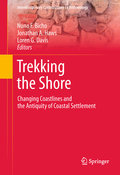
Trekking the shore: changing coastlines and the antiquity of coastal settlement
Bicho, Nuno F.
Haws, Jonathan A.
Davis, Loren G.
Human settlement has often centered around coastal areas and waterways. Untilrecently, however, archaeologists believed that marine economies did not develop until the end of the Pleistocene, when the archaeological record begins tohave evidence of marine life as part of the human diet. This has long been interpreted as a postglacial adaptation, due to the rise in sea level and subsequent decrease in terrestrial resources. Coastal resources, particularly mollusks, were viewed as fallback resources, which people resorted to only when terrestrial resources were scarce, included only as part of a more complex diet. Recent research has significantly altered this understanding, known as the Broad Spectrum Revolution (BSR) model. The contributions to this volume revise theBSR model, with evidence that coastal resources were an important part of human economies and subsistence much earlier than previously thought, and even the main focus of diets for some Pleistocene and early Holocene hunter-gatherer societies. With evidence from North and South America, Europe, Africa, Asia, and Australia, this volume comprehensively lends a new understanding to coastalsettlement from the Middle Paleolithic to the Middle Holocene. New evidence to expand the current Broad Spectrum Revolution model. Contributions cover coastal regions from five continents in one volume. Synthesizes past decade of research on coastal settlement and resources in hunter-gatherereconomies. INDICE: Introduction. Trekking the shore, harvesting the sea changing coastlines and the antiquity of coastal settlement. Part I: North America and Eurasia. The North American Paleocoastal Concept Reconsidered. Prehistoric Archaeology Underwater: A Nascent Subdiscipline Critical to Understanding Early Coastal Occupations and Migration Routes. Early Environments and Archaeology of Coastal British Columbia. Blessing the Salmon: Archaeological Evidences of the Transition to Intensive Fishing in the Final Paleolithic, Maritime Region, Russian Far East. Early Technological Organization along the Eastern Pacific Rim ofthe New World: A co-continental view. Technology, mobility, and adaptation among early foragers of the southern Northwest Coast: The view from Indian Sands, southern Oregon coast, USA. Of Clams and Clovis: Isla Cedros, Baja California, Mexico. Changes in the molluscan exploitation patterns during the late Pleistocene and early Holocene in the eastern Cantabria (Spain). Paleolithic seascapes along the west coast of Portugal. Small-game and marine resource exploitation by Neanderthals: The evidence from Gibraltar. Prying new meaning from limpet harvesting at Vale Boi during the Upper Paleolithic. Surf and Turf: The use of marine and terrestrial resources in the Early Neolithic of costal southern Portugal. Part II: South America, Africa and Oceania. Sea lions and human populations in Southern Patagonia. The Use of the Space in Pampean Atlantic Coast (Argentina, South America): A Comparative View. Coastal Resources and the Early Holocene Las Vegas Adaptation of Ecuador. Initial investigations into the exploitation of coastal resources in North Africa during the Late Pleistocene at Grotte des Contrebandiers, Morocco. Shellfishing and the interpretation of shellfish sizes in the Middle and Later Stone Ages of South Africa. Coastal South Africa and the co-evolution of the modern human lineage and coastal adaptations. Coastal Foragers on Southern Shores: Marine Resource Use in NortheastAustralia since the Late Pleistocene. The role of marine resources in the diet of pre-colonial Aboriginal people and land use patterns around Port Jackson,Sydney, New South Wales, Australia.
- ISBN: 978-1-4419-8218-6
- Editorial: Springer New York
- Encuadernacion: Cartoné
- Páginas: 496
- Fecha Publicación: 20/05/2011
- Nº Volúmenes: 1
- Idioma: Inglés
